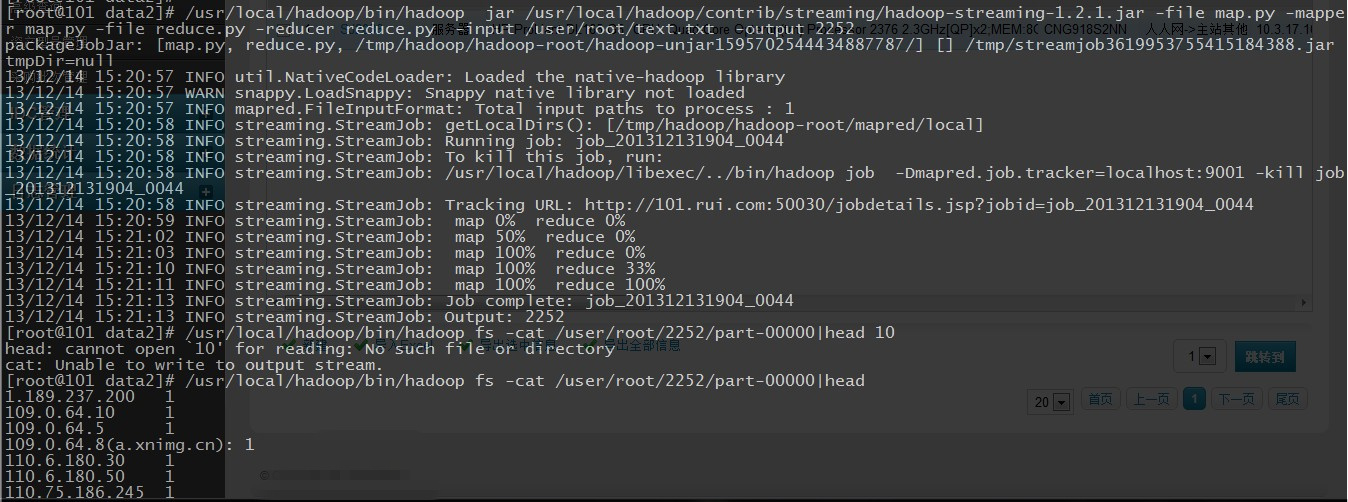
图片 19.1 pic
流量比较大的日志要是直接写入 Hadoop 对 Namenode 负载过大,所以入库前合并,可以把各个节点的日志凑并成一个文件写入 HDFS。 根据情况定期合成,写入到 hdfs 里面。
咱们看看日志的大小,200 G 的 dns 日志文件,我压缩到了 18 G,要是用 awk perl 当然也可以,但是处理速度肯定没有分布式那样的给力。

图片 19.2 pic
Hadoop Streaming 原理
mapper 和 reducer 会从标准输入中读取用户数据,一行一行处理后发送给标准输出。Streaming 工具会创建 MapReduce 作业,发送给各个 tasktracker,同时监控整个作业的执行过程。
任何语言,只要是方便接收标准输入输出就可以做 mapreduce~
再搞之前我们先简单测试下 shell 模拟 mapreduce 的性能速度~

图片 19.3 pic
看下他的结果,350 M 的文件用时 35 秒左右。

图片 19.4 pic
这是 2 G 的日志文件,居然用了 3 分钟。 当然和我写的脚本也有问题,我们是模拟 mapreduce 的方式,而不是调用 shell 下牛逼的 awk,gawk 处理。

图片 19.5 pic
awk 的速度!果然很霸道,处理日志的时候,我也很喜欢用 awk,只是学习的难度有点大,不像别的 shell 组件那么灵活简单。

图片 19.6 pic
这是官方的提供的两个 demo ~
map.py
#!/usr/bin/env python"""A more advanced Mapper, using Python iterators and generators."""import sysdef read_input(file): for line in file:# split the line into wordsyield line.splitdef main(separator=\'t\'): # input comes from STDIN (standard input) data = read_input(sys.stdin) for words in data:# write the results to STDOUT (standard output);# what we output here will be the input for the# Reduce step, i.e. the input for reducer.py## tab-delimited; the trivial word count is 1for word in words: print \'%s%s%d\' % (word, separator, 1)if __name__ == "__main__": main
reduce.py 的修改方式
#!/usr/bin/env python"""A more advanced Reducer, using Python iterators and generators."""from itertools import groupbyfrom operator import itemgetterimport sysdef read_mapper_output(file, separator=\'t\'): for line in file:yield line.rstrip.split(separator, 1)def main(separator=\'t\'): # input comes from STDIN (standard input) data = read_mapper_output(sys.stdin, separator=separator) # groupby groups multiple word-count pairs by word, # and creates an iterator that returns consecutive keys and their group: # current_word - string containing a word (the key) # group - iterator yielding all ["<current_word>", "<count>"] items for current_word, group in groupby(data, itemgetter(0)):try: total_count = sum(int(count) for current_word, count in group) print "%s%s%d" % (current_word, separator, total_count)except ValueError: # count was not a number, so silently discard this item passif __name__ == "__main__": main
咱们再简单点:
#!/usr/bin/env pythonimport sysfor line in sys.stdin: line = line.strip words = line.split for word in words:print \'%st%s\' % (word, 1)
#!/usr/bin/env pythonfrom operator import itemgetterimport syscurrent_word = Nonecurrent_count = 0word = Nonefor line in sys.stdin: line = line.strip word, count = line.split(\'t\', 1) try:count = int(count) except ValueError:continue if current_word == word:current_count += count else:if current_word: print \'%st%s\' % (current_word, current_count)current_count = countcurrent_word = wordif current_word == word: print \'%st%s\' % (current_word, current_count)
咱们就简单模拟下数据,跑个测试

图片 19.7 pic
剩下就没啥了,在 hadoop 集群环境下,运行 hadoop 的 steaming.jar 组件,加入 mapreduce 的脚本,指定输出就行了. 下面的例子我用的是 shell 的成分。
[root@101 cron]#$HADOOP_HOME/bin/hadoop jar $HADOOP_HOME/contrib/streaming/hadoop-*-streaming.jar -input myInputDirs -output myOutputDir -mapper cat -reducer wc
详细的参数,对于咱们来说提供性能可以把 tasks 的任务数增加下,根据情况自己测试下,也别太高了,增加负担。
(1)-input:输入文件路径
(2)-output:输出文件路径
(3)-mapper:用户自己写的 mapper 程序,可以是可执行文件或者脚本
(4)-reducer:用户自己写的 reducer 程序,可以是可执行文件或者脚本
(5)-file:打包文件到提交的作业中,可以是 mapper 或者 reducer 要用的输入文件,如配置文件,字典等。
(6)-partitioner:用户自定义的 partitioner 程序
(7)-combiner:用户自定义的 combiner 程序(必须用 java 实现)
(8)-D:作业的一些属性(以前用的是-jonconf),具体有:
1)mapred.map.tasks:map task 数目
2)mapred.reduce.tasks:reduce task 数目
3)stream.map.input.field.separator/stream.map.output.field.separator: map task 输入/输出数据的分隔符,默认均为 t。
4)stream.num.map.output.key.fields:指定 map task 输出记录中 key 所占的域数目
5)stream.reduce.input.field.separator/stream.reduce.output.field.separator:reduce task 输入/输出数据的分隔符,默认均为 t。
6)stream.num.reduce.output.key.fields:指定 reduce task 输出记录中 key 所占的域数目
这里是统计 dns 的日志文件有多少行 ~

图片 19.8 pic
在 mapreduce 作为参数的时候,不能用太多太复杂的 shell 语言,他不懂的~
可以写成 shell 文件的模式;
#! /bin/bashwhile read LINE; do # for word in $LINE # do # echo "$word 1"awk \'{print $5}\' donedone #! /bin/bashcount=0started=0word=""while read LINE;do goodk=`echo $LINE | cut -d \' \' -f 1` if [ "x" == x"$goodk" ];then continue fi if [ "$word" != "$goodk" ];then [ $started -ne 0 ] && echo -e "$wordt$count" word=$goodk count=1 started=1 else count=$(( $count + 1 )) fidone
有时候会出现这样的问题,好好看看自己写的 mapreduce 程序 ~
13/12/14 13:26:52 INFO streaming.StreamJob: Tracking URL: http://101.rui.com:50030/jobdetails.jsp?jobid=job_201312131904_003013/12/14 13:26:53 INFO streaming.StreamJob: map 0% reduce 0%13/12/14 13:27:16 INFO streaming.StreamJob: map 100% reduce 100%13/12/14 13:27:16 INFO streaming.StreamJob: To kill this job, run:13/12/14 13:27:16 INFO streaming.StreamJob: /usr/local/hadoop/libexec/../bin/hadoop job -Dmapred.job.tracker=localhost:9001 -kill job_201312131904_003013/12/14 13:27:16 INFO streaming.StreamJob: Tracking URL: http://101.rui.com:50030/jobdetails.jsp?jobid=job_201312131904_003013/12/14 13:27:16 ERROR streaming.StreamJob: Job not successful. Error: # of failed Map Tasks exceeded allowed limit. FailedCount: 1. LastFailedTask: task_201312131904_0030_m_00000013/12/14 13:27:16 INFO streaming.StreamJob: killJob...Streaming Command Failed!
python 做为 mapreduce 执行成功后,结果和日志一般是放在你指定的目录下的,结果是在 part-00000 文件里面~

图片 19.9 pic
下面咱们谈下,如何入库和后台的执行
本文出自 “峰云,就她了。” 博客,谢绝转载!
